Literature Review on Postpartum Depression: Causes and Risks
VerifiedAdded on 2023/06/18
|10
|2553
|249
Literature Review
AI Summary
This literature review explores postpartum depression, a complex condition affecting women after childbirth. It delves into the concept of postpartum depression, discussing the emotional, behavioral, and physical changes associated with it, including mood swings, anxiety, and sleep difficulties. The review examines the chemical, social, and psychological factors contributing to postpartum depression, such as hormonal shifts, lack of sleep, and self-image issues. It identifies various causes and risk factors, including a history of depression, age, ambivalence about pregnancy, family history of mood disorders, stressful life events, and limited social support. Furthermore, it discusses ways to minimize postpartum depression, including medication, psychotherapy, and emotional support. The review concludes by emphasizing the importance of early diagnosis and treatment to reduce complications for both the mother and child.
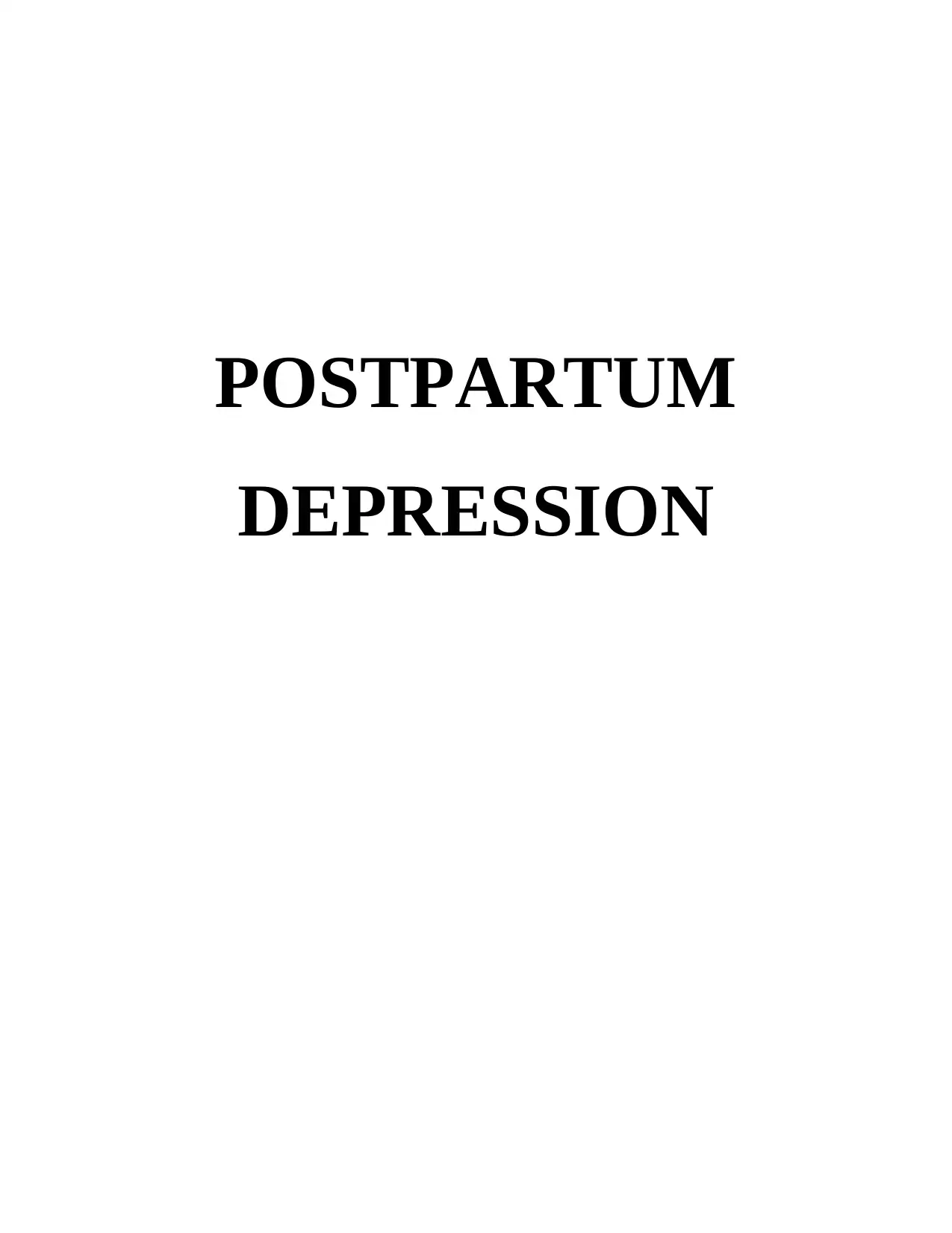
POSTPARTUM
DEPRESSION
DEPRESSION
Paraphrase This Document
Need a fresh take? Get an instant paraphrase of this document with our AI Paraphraser
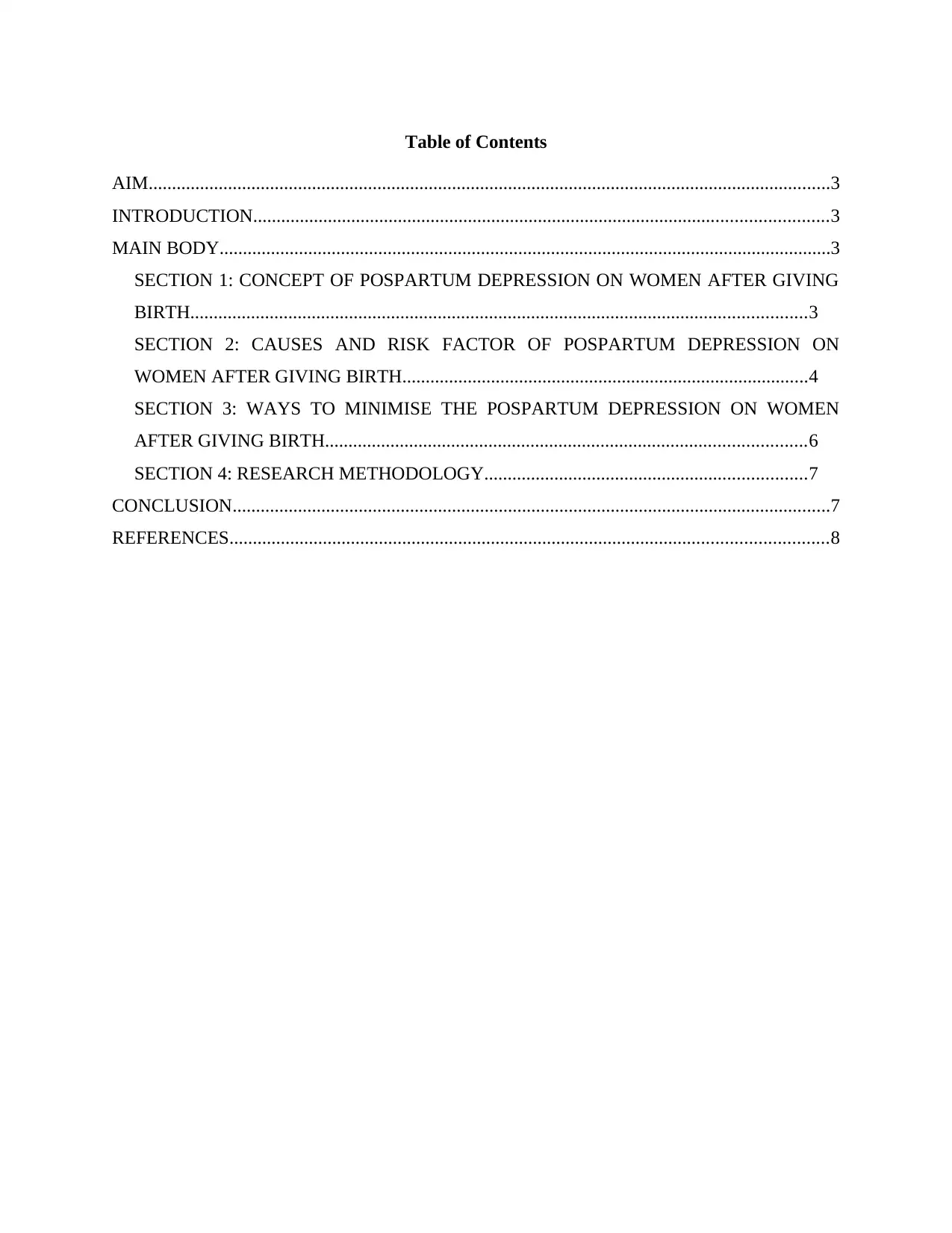
Table of Contents
AIM..................................................................................................................................................3
INTRODUCTION...........................................................................................................................3
MAIN BODY...................................................................................................................................3
SECTION 1: CONCEPT OF POSPARTUM DEPRESSION ON WOMEN AFTER GIVING
BIRTH....................................................................................................................................3
SECTION 2: CAUSES AND RISK FACTOR OF POSPARTUM DEPRESSION ON
WOMEN AFTER GIVING BIRTH.......................................................................................4
SECTION 3: WAYS TO MINIMISE THE POSPARTUM DEPRESSION ON WOMEN
AFTER GIVING BIRTH.......................................................................................................6
SECTION 4: RESEARCH METHODOLOGY.....................................................................7
CONCLUSION................................................................................................................................7
REFERENCES................................................................................................................................8
AIM..................................................................................................................................................3
INTRODUCTION...........................................................................................................................3
MAIN BODY...................................................................................................................................3
SECTION 1: CONCEPT OF POSPARTUM DEPRESSION ON WOMEN AFTER GIVING
BIRTH....................................................................................................................................3
SECTION 2: CAUSES AND RISK FACTOR OF POSPARTUM DEPRESSION ON
WOMEN AFTER GIVING BIRTH.......................................................................................4
SECTION 3: WAYS TO MINIMISE THE POSPARTUM DEPRESSION ON WOMEN
AFTER GIVING BIRTH.......................................................................................................6
SECTION 4: RESEARCH METHODOLOGY.....................................................................7
CONCLUSION................................................................................................................................7
REFERENCES................................................................................................................................8

AIM
“To evaluate the causes and risk factors of postpartum depression on women" as it affects
women who have newly given birth”.
INTRODUCTION
Postpartum depression is defined as the complex mix of physical, emotional and behavioural
changes which is happen in some of the women after giving birth to child. As per this, with the
reference of DSM-5, a manual change is also observed which is associated with major
depression which is started within the 4 week of pregnancy or delivery of child (Alhasanat-
Khalil and et. al., 2018). Moreover, the diagnosis of the postpartum depression is usually
observed in the various aspect that is associated with the length of time that is between delivery
and onset but is majorly based on the form of depression. However, the postpartum depression is
always associated with the chemical, social and psychological variation which is happen when
the situation of having child is arises (Everything You Need to Know About Postpartum
Depression, 2021). This term is elaborated by taking the contrast which show the range of
physical and emotional change which may experience new mother. In this, the report is discussed
and cover about the core concept of postpartum depression with a developed understanding of
causes and risk factor which is mainly formulated during postpartum depression. In this, some of
ways and intervention is also elaborated in order to reduce the complication (Choi and et. al.,
2017).
MAIN BODY
SECTION 1: CONCEPT OF POSPARTUM DEPRESSION ON WOMEN AFTER GIVING
BIRTH
The major concept which is arise during the study of postpartum depression which is based
on birth of baby which can trigger a bunch of feeling and powerful emotion from excitement and
joy to transform in to fear and anxiety. As per this, it also can show the results of something
which is usually affected and expected as a form of depression. In recent time, when any new
mother experience the postpartum depression after a child birth which include some of common
mood swing and other associated factor such as crying spells, anxiety and difficulty in sleeping.
In this, the baby blue is typically beginning with first to three days after the delivery which may
extended up to last two weeks. Moreover, there are various chemical, social and psychological
“To evaluate the causes and risk factors of postpartum depression on women" as it affects
women who have newly given birth”.
INTRODUCTION
Postpartum depression is defined as the complex mix of physical, emotional and behavioural
changes which is happen in some of the women after giving birth to child. As per this, with the
reference of DSM-5, a manual change is also observed which is associated with major
depression which is started within the 4 week of pregnancy or delivery of child (Alhasanat-
Khalil and et. al., 2018). Moreover, the diagnosis of the postpartum depression is usually
observed in the various aspect that is associated with the length of time that is between delivery
and onset but is majorly based on the form of depression. However, the postpartum depression is
always associated with the chemical, social and psychological variation which is happen when
the situation of having child is arises (Everything You Need to Know About Postpartum
Depression, 2021). This term is elaborated by taking the contrast which show the range of
physical and emotional change which may experience new mother. In this, the report is discussed
and cover about the core concept of postpartum depression with a developed understanding of
causes and risk factor which is mainly formulated during postpartum depression. In this, some of
ways and intervention is also elaborated in order to reduce the complication (Choi and et. al.,
2017).
MAIN BODY
SECTION 1: CONCEPT OF POSPARTUM DEPRESSION ON WOMEN AFTER GIVING
BIRTH
The major concept which is arise during the study of postpartum depression which is based
on birth of baby which can trigger a bunch of feeling and powerful emotion from excitement and
joy to transform in to fear and anxiety. As per this, it also can show the results of something
which is usually affected and expected as a form of depression. In recent time, when any new
mother experience the postpartum depression after a child birth which include some of common
mood swing and other associated factor such as crying spells, anxiety and difficulty in sleeping.
In this, the baby blue is typically beginning with first to three days after the delivery which may
extended up to last two weeks. Moreover, there are various chemical, social and psychological
⊘ This is a preview!⊘
Do you want full access?
Subscribe today to unlock all pages.

Trusted by 1+ million students worldwide
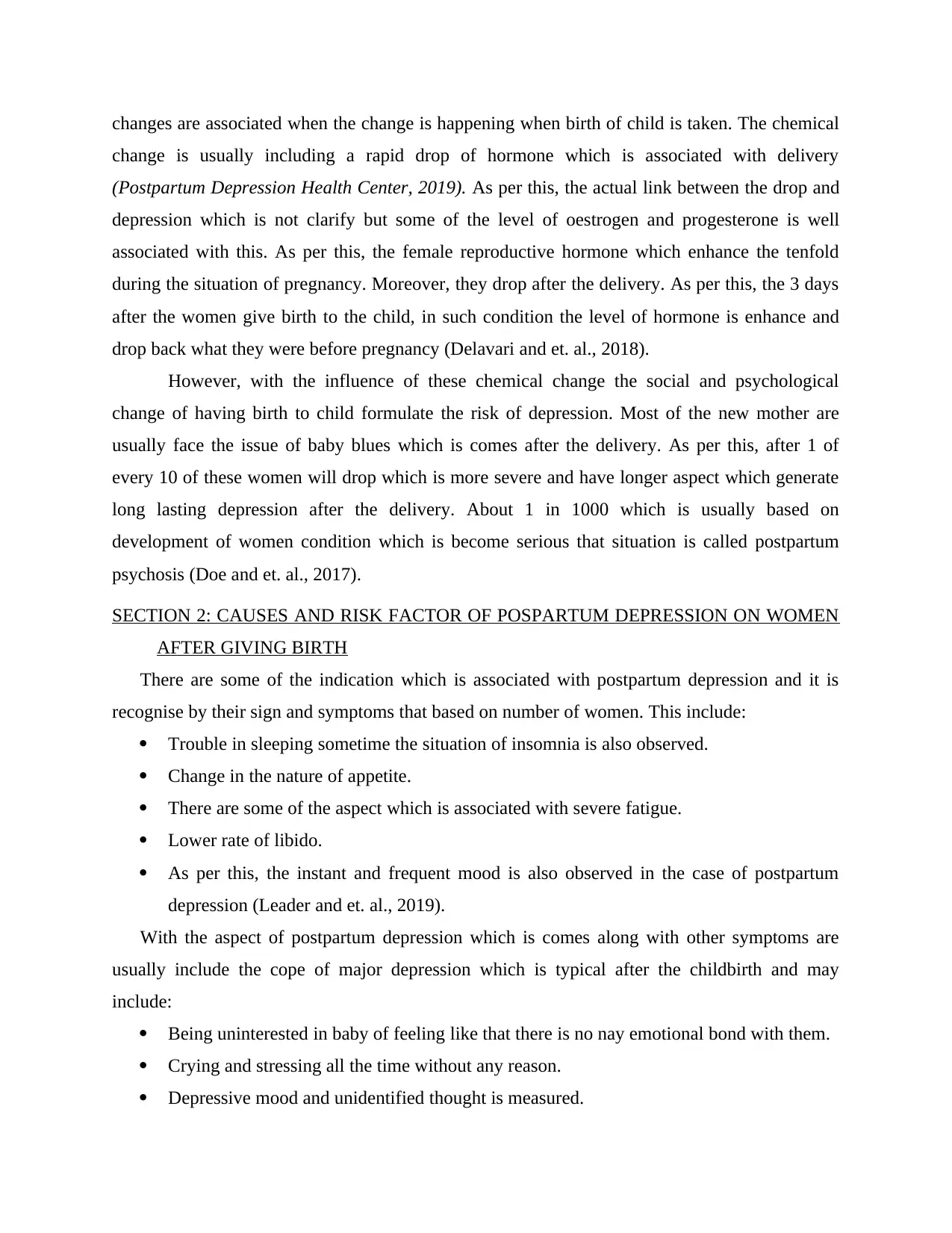
changes are associated when the change is happening when birth of child is taken. The chemical
change is usually including a rapid drop of hormone which is associated with delivery
(Postpartum Depression Health Center, 2019). As per this, the actual link between the drop and
depression which is not clarify but some of the level of oestrogen and progesterone is well
associated with this. As per this, the female reproductive hormone which enhance the tenfold
during the situation of pregnancy. Moreover, they drop after the delivery. As per this, the 3 days
after the women give birth to the child, in such condition the level of hormone is enhance and
drop back what they were before pregnancy (Delavari and et. al., 2018).
However, with the influence of these chemical change the social and psychological
change of having birth to child formulate the risk of depression. Most of the new mother are
usually face the issue of baby blues which is comes after the delivery. As per this, after 1 of
every 10 of these women will drop which is more severe and have longer aspect which generate
long lasting depression after the delivery. About 1 in 1000 which is usually based on
development of women condition which is become serious that situation is called postpartum
psychosis (Doe and et. al., 2017).
SECTION 2: CAUSES AND RISK FACTOR OF POSPARTUM DEPRESSION ON WOMEN
AFTER GIVING BIRTH
There are some of the indication which is associated with postpartum depression and it is
recognise by their sign and symptoms that based on number of women. This include:
Trouble in sleeping sometime the situation of insomnia is also observed.
Change in the nature of appetite.
There are some of the aspect which is associated with severe fatigue.
Lower rate of libido.
As per this, the instant and frequent mood is also observed in the case of postpartum
depression (Leader and et. al., 2019).
With the aspect of postpartum depression which is comes along with other symptoms are
usually include the cope of major depression which is typical after the childbirth and may
include:
Being uninterested in baby of feeling like that there is no nay emotional bond with them.
Crying and stressing all the time without any reason.
Depressive mood and unidentified thought is measured.
change is usually including a rapid drop of hormone which is associated with delivery
(Postpartum Depression Health Center, 2019). As per this, the actual link between the drop and
depression which is not clarify but some of the level of oestrogen and progesterone is well
associated with this. As per this, the female reproductive hormone which enhance the tenfold
during the situation of pregnancy. Moreover, they drop after the delivery. As per this, the 3 days
after the women give birth to the child, in such condition the level of hormone is enhance and
drop back what they were before pregnancy (Delavari and et. al., 2018).
However, with the influence of these chemical change the social and psychological
change of having birth to child formulate the risk of depression. Most of the new mother are
usually face the issue of baby blues which is comes after the delivery. As per this, after 1 of
every 10 of these women will drop which is more severe and have longer aspect which generate
long lasting depression after the delivery. About 1 in 1000 which is usually based on
development of women condition which is become serious that situation is called postpartum
psychosis (Doe and et. al., 2017).
SECTION 2: CAUSES AND RISK FACTOR OF POSPARTUM DEPRESSION ON WOMEN
AFTER GIVING BIRTH
There are some of the indication which is associated with postpartum depression and it is
recognise by their sign and symptoms that based on number of women. This include:
Trouble in sleeping sometime the situation of insomnia is also observed.
Change in the nature of appetite.
There are some of the aspect which is associated with severe fatigue.
Lower rate of libido.
As per this, the instant and frequent mood is also observed in the case of postpartum
depression (Leader and et. al., 2019).
With the aspect of postpartum depression which is comes along with other symptoms are
usually include the cope of major depression which is typical after the childbirth and may
include:
Being uninterested in baby of feeling like that there is no nay emotional bond with them.
Crying and stressing all the time without any reason.
Depressive mood and unidentified thought is measured.
Paraphrase This Document
Need a fresh take? Get an instant paraphrase of this document with our AI Paraphraser

Severe anger and crankiness.
Loss of pleasure.
Feeling hopeless and helplessness which is create critical condition with mother. Thought of hurting someone and create chaos (Postpartum depression, 2018).
Difficulty in focus and developing understanding this also render in order to take
decision.
With this, there are number of reason which is analyse in different for different people
(O'Hara and et. al., 2019). In this, some of the thing which can enhance the chance of postpartum
depression majorly include:
There is always a history which is associated with depression prior to become pregnant or
during the pregnancy.
With the aspect of time the age is also determined which is based on pregnancy.
Ambivalence which is related with the pregnancy.
Children which is more likely to show that the depression is later pregnancy.
Sometime, family history of mood disorder is also related with this which act as
enhancing factor.
With this, going with a stressful event which is associated with the job loss and health
crisis.
Having any child in past or with current which is associated with special ned or health
issue.
Moreover, having twins and triplet is also a major cause.
Limited social support.
Living alone which can create more conflict and chaos.
Marital conflict.
Therefore, there is no cause of postpartum depression, but these physical and emotional may
use to contribute with every aspect (Postpartum Depression, 2020). Some of them include:
Hormone: There are drastic change which is occur in the oestrogen and progesterone which have
some of the birth which play a role. In this, the other hormone produced by thyroid gland which
may drop sharply and make feel tired, sluggish and depressed.
Lack of sleep: Situation become more dramatic when the symptoms of insomnia is observed
which can create minor problem.
Loss of pleasure.
Feeling hopeless and helplessness which is create critical condition with mother. Thought of hurting someone and create chaos (Postpartum depression, 2018).
Difficulty in focus and developing understanding this also render in order to take
decision.
With this, there are number of reason which is analyse in different for different people
(O'Hara and et. al., 2019). In this, some of the thing which can enhance the chance of postpartum
depression majorly include:
There is always a history which is associated with depression prior to become pregnant or
during the pregnancy.
With the aspect of time the age is also determined which is based on pregnancy.
Ambivalence which is related with the pregnancy.
Children which is more likely to show that the depression is later pregnancy.
Sometime, family history of mood disorder is also related with this which act as
enhancing factor.
With this, going with a stressful event which is associated with the job loss and health
crisis.
Having any child in past or with current which is associated with special ned or health
issue.
Moreover, having twins and triplet is also a major cause.
Limited social support.
Living alone which can create more conflict and chaos.
Marital conflict.
Therefore, there is no cause of postpartum depression, but these physical and emotional may
use to contribute with every aspect (Postpartum Depression, 2020). Some of them include:
Hormone: There are drastic change which is occur in the oestrogen and progesterone which have
some of the birth which play a role. In this, the other hormone produced by thyroid gland which
may drop sharply and make feel tired, sluggish and depressed.
Lack of sleep: Situation become more dramatic when the symptoms of insomnia is observed
which can create minor problem.
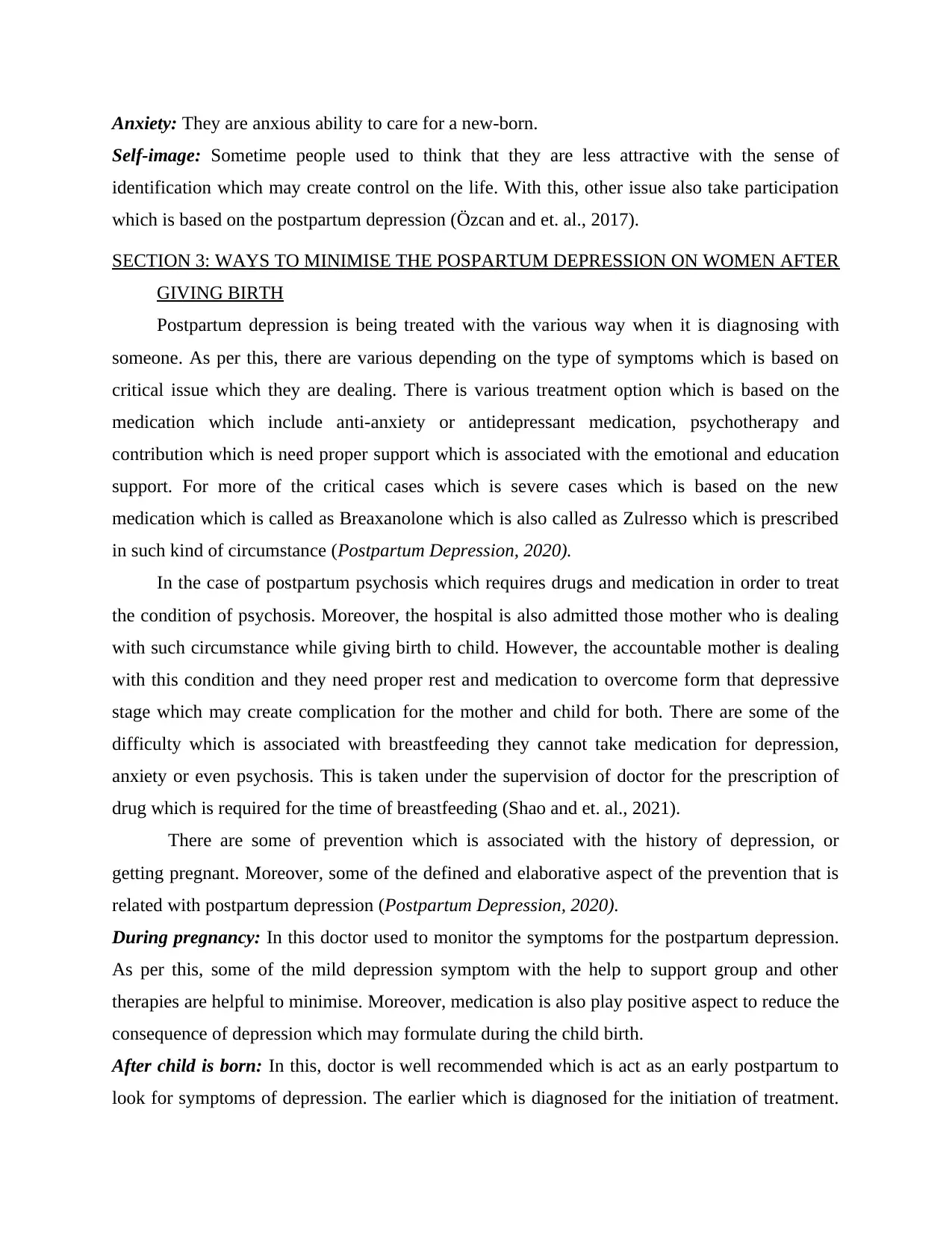
Anxiety: They are anxious ability to care for a new-born.
Self-image: Sometime people used to think that they are less attractive with the sense of
identification which may create control on the life. With this, other issue also take participation
which is based on the postpartum depression (Özcan and et. al., 2017).
SECTION 3: WAYS TO MINIMISE THE POSPARTUM DEPRESSION ON WOMEN AFTER
GIVING BIRTH
Postpartum depression is being treated with the various way when it is diagnosing with
someone. As per this, there are various depending on the type of symptoms which is based on
critical issue which they are dealing. There is various treatment option which is based on the
medication which include anti-anxiety or antidepressant medication, psychotherapy and
contribution which is need proper support which is associated with the emotional and education
support. For more of the critical cases which is severe cases which is based on the new
medication which is called as Breaxanolone which is also called as Zulresso which is prescribed
in such kind of circumstance (Postpartum Depression, 2020).
In the case of postpartum psychosis which requires drugs and medication in order to treat
the condition of psychosis. Moreover, the hospital is also admitted those mother who is dealing
with such circumstance while giving birth to child. However, the accountable mother is dealing
with this condition and they need proper rest and medication to overcome form that depressive
stage which may create complication for the mother and child for both. There are some of the
difficulty which is associated with breastfeeding they cannot take medication for depression,
anxiety or even psychosis. This is taken under the supervision of doctor for the prescription of
drug which is required for the time of breastfeeding (Shao and et. al., 2021).
There are some of prevention which is associated with the history of depression, or
getting pregnant. Moreover, some of the defined and elaborative aspect of the prevention that is
related with postpartum depression (Postpartum Depression, 2020).
During pregnancy: In this doctor used to monitor the symptoms for the postpartum depression.
As per this, some of the mild depression symptom with the help to support group and other
therapies are helpful to minimise. Moreover, medication is also play positive aspect to reduce the
consequence of depression which may formulate during the child birth.
After child is born: In this, doctor is well recommended which is act as an early postpartum to
look for symptoms of depression. The earlier which is diagnosed for the initiation of treatment.
Self-image: Sometime people used to think that they are less attractive with the sense of
identification which may create control on the life. With this, other issue also take participation
which is based on the postpartum depression (Özcan and et. al., 2017).
SECTION 3: WAYS TO MINIMISE THE POSPARTUM DEPRESSION ON WOMEN AFTER
GIVING BIRTH
Postpartum depression is being treated with the various way when it is diagnosing with
someone. As per this, there are various depending on the type of symptoms which is based on
critical issue which they are dealing. There is various treatment option which is based on the
medication which include anti-anxiety or antidepressant medication, psychotherapy and
contribution which is need proper support which is associated with the emotional and education
support. For more of the critical cases which is severe cases which is based on the new
medication which is called as Breaxanolone which is also called as Zulresso which is prescribed
in such kind of circumstance (Postpartum Depression, 2020).
In the case of postpartum psychosis which requires drugs and medication in order to treat
the condition of psychosis. Moreover, the hospital is also admitted those mother who is dealing
with such circumstance while giving birth to child. However, the accountable mother is dealing
with this condition and they need proper rest and medication to overcome form that depressive
stage which may create complication for the mother and child for both. There are some of the
difficulty which is associated with breastfeeding they cannot take medication for depression,
anxiety or even psychosis. This is taken under the supervision of doctor for the prescription of
drug which is required for the time of breastfeeding (Shao and et. al., 2021).
There are some of prevention which is associated with the history of depression, or
getting pregnant. Moreover, some of the defined and elaborative aspect of the prevention that is
related with postpartum depression (Postpartum Depression, 2020).
During pregnancy: In this doctor used to monitor the symptoms for the postpartum depression.
As per this, some of the mild depression symptom with the help to support group and other
therapies are helpful to minimise. Moreover, medication is also play positive aspect to reduce the
consequence of depression which may formulate during the child birth.
After child is born: In this, doctor is well recommended which is act as an early postpartum to
look for symptoms of depression. The earlier which is diagnosed for the initiation of treatment.
⊘ This is a preview!⊘
Do you want full access?
Subscribe today to unlock all pages.

Trusted by 1+ million students worldwide
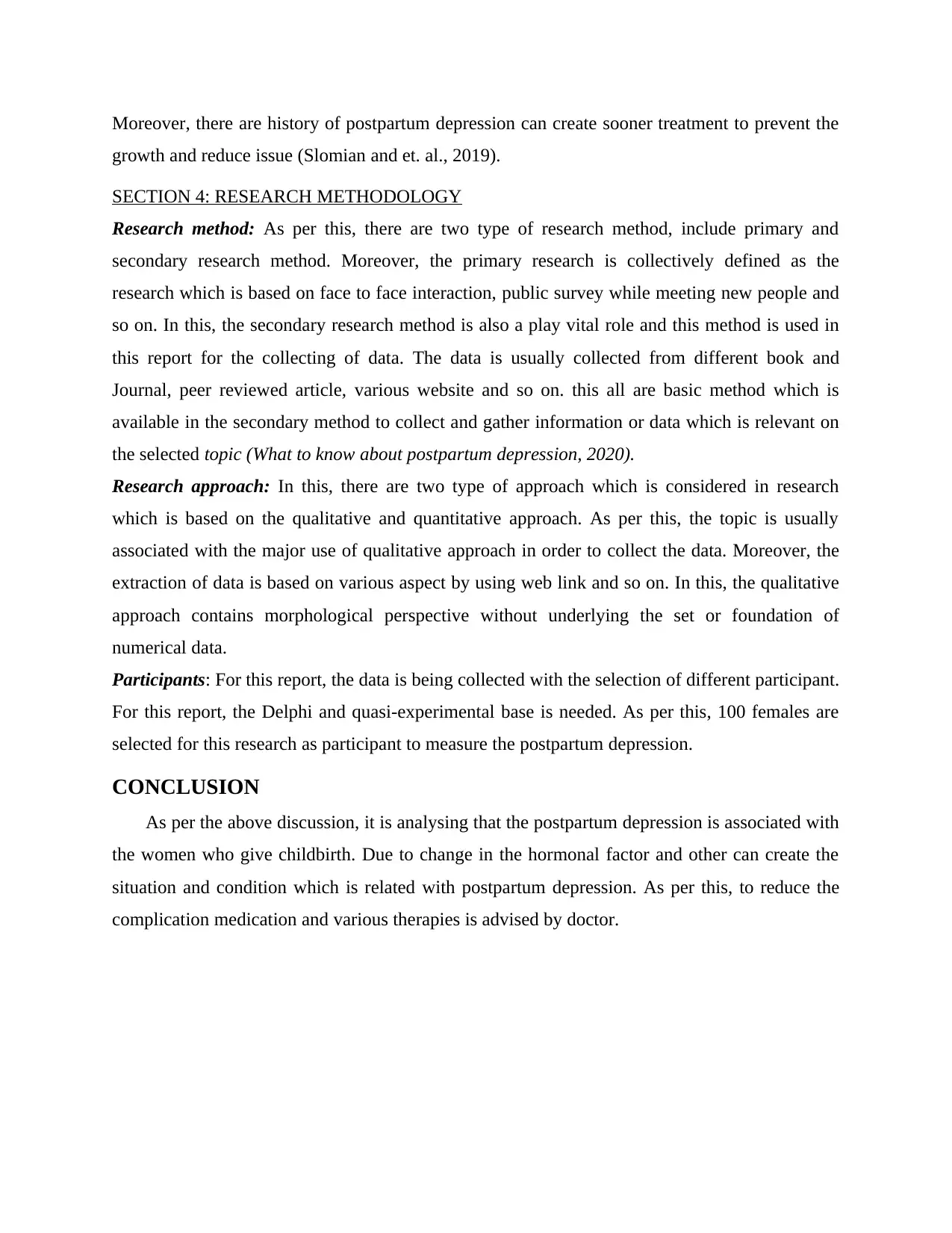
Moreover, there are history of postpartum depression can create sooner treatment to prevent the
growth and reduce issue (Slomian and et. al., 2019).
SECTION 4: RESEARCH METHODOLOGY
Research method: As per this, there are two type of research method, include primary and
secondary research method. Moreover, the primary research is collectively defined as the
research which is based on face to face interaction, public survey while meeting new people and
so on. In this, the secondary research method is also a play vital role and this method is used in
this report for the collecting of data. The data is usually collected from different book and
Journal, peer reviewed article, various website and so on. this all are basic method which is
available in the secondary method to collect and gather information or data which is relevant on
the selected topic (What to know about postpartum depression, 2020).
Research approach: In this, there are two type of approach which is considered in research
which is based on the qualitative and quantitative approach. As per this, the topic is usually
associated with the major use of qualitative approach in order to collect the data. Moreover, the
extraction of data is based on various aspect by using web link and so on. In this, the qualitative
approach contains morphological perspective without underlying the set or foundation of
numerical data.
Participants: For this report, the data is being collected with the selection of different participant.
For this report, the Delphi and quasi-experimental base is needed. As per this, 100 females are
selected for this research as participant to measure the postpartum depression.
CONCLUSION
As per the above discussion, it is analysing that the postpartum depression is associated with
the women who give childbirth. Due to change in the hormonal factor and other can create the
situation and condition which is related with postpartum depression. As per this, to reduce the
complication medication and various therapies is advised by doctor.
growth and reduce issue (Slomian and et. al., 2019).
SECTION 4: RESEARCH METHODOLOGY
Research method: As per this, there are two type of research method, include primary and
secondary research method. Moreover, the primary research is collectively defined as the
research which is based on face to face interaction, public survey while meeting new people and
so on. In this, the secondary research method is also a play vital role and this method is used in
this report for the collecting of data. The data is usually collected from different book and
Journal, peer reviewed article, various website and so on. this all are basic method which is
available in the secondary method to collect and gather information or data which is relevant on
the selected topic (What to know about postpartum depression, 2020).
Research approach: In this, there are two type of approach which is considered in research
which is based on the qualitative and quantitative approach. As per this, the topic is usually
associated with the major use of qualitative approach in order to collect the data. Moreover, the
extraction of data is based on various aspect by using web link and so on. In this, the qualitative
approach contains morphological perspective without underlying the set or foundation of
numerical data.
Participants: For this report, the data is being collected with the selection of different participant.
For this report, the Delphi and quasi-experimental base is needed. As per this, 100 females are
selected for this research as participant to measure the postpartum depression.
CONCLUSION
As per the above discussion, it is analysing that the postpartum depression is associated with
the women who give childbirth. Due to change in the hormonal factor and other can create the
situation and condition which is related with postpartum depression. As per this, to reduce the
complication medication and various therapies is advised by doctor.
Paraphrase This Document
Need a fresh take? Get an instant paraphrase of this document with our AI Paraphraser

REFERENCES
Books and Journals
Alhasanat-Khalil and et. al., 2018. Acculturative stress and lack of social support predict
postpartum depression among US immigrant women of Arabic descent. Archives of
psychiatric nursing, 32(4), pp.530-535.
Choi and et. al., 2017. Maternal childhood trauma, postpartum depression, and infant outcomes:
Avoidant affective processing as a potential mechanism. Journal of Affective
Disorders, 211, pp.107-115.
Delavari and et. al., 2018. The relationship of maternal-fetal attachment and postpartum
depression: A longitudinal study. Archives of psychiatric nursing, 32(2), pp.263-267.
Doe and et. al., 2017. Prevalence and predictors of positive screening for postpartum depression
in minority parturients in the South Bronx. Archives of women's mental health, 20(2),
pp.291-295.
Leader and et. al., 2019. Brexanolone for postpartum depression: clinical evidence and practical
considerations. Pharmacotherapy: The Journal of Human Pharmacology and Drug
Therapy, 39(11), pp.1105-1112.
O'Hara and et. al., 2019. A placebo controlled treatment trial of sertraline and interpersonal
psychotherapy for postpartum depression. Journal of affective disorders, 245, pp.524-
532.
Özcan and et. al., 2017. Postpartum depression prevalence and risk factors in Turkey: a
systematic review and meta-analysis. Archives of psychiatric nursing, 31(4), pp.420-428.
Shao and et. al., 2021. Prevalence of Postpartum Depression and Associated Predictors Among
Taiwanese Women in a Mother-Child Friendly Hospital. Asia Pacific Journal of Public
Health, p.10105395211001172.
Slomian and et. al., 2019. Consequences of maternal postpartum depression: A systematic review
of maternal and infant outcomes. Women's Health, 15, p.1745506519844044.
Online
Everything You Need to Know About Postpartum Depression, 2021 [Online] Available through:
https://www.healthline.com/health/depression/postpartum-depression#tips
Postpartum Depression Health Center, 2019 [Online] Available through:
https://www.webmd.com/depression/postpartum-depression/default.htm
Postpartum depression, 2018 [Online] Available through:
https://www.womenshealth.gov/mental-health/mental-health-conditions/postpartum-
depression
Postpartum Depression, 2020 [Online] Available through:
https://kidshealth.org/en/parents/ppd.html
Postpartum Depression, 2020 [Online] Available through:
https://my.clevelandclinic.org/health/diseases/9312-postpartum-depression
Postpartum Depression, 2020 [Online] Available through:
https://www.webmd.com/depression/guide/postpartum-depression
Postpartum depression, 2021 [Online] Available through: https://www.mayoclinic.org/diseases-
conditions/postpartum-depression/symptoms-causes/syc-20376617
Books and Journals
Alhasanat-Khalil and et. al., 2018. Acculturative stress and lack of social support predict
postpartum depression among US immigrant women of Arabic descent. Archives of
psychiatric nursing, 32(4), pp.530-535.
Choi and et. al., 2017. Maternal childhood trauma, postpartum depression, and infant outcomes:
Avoidant affective processing as a potential mechanism. Journal of Affective
Disorders, 211, pp.107-115.
Delavari and et. al., 2018. The relationship of maternal-fetal attachment and postpartum
depression: A longitudinal study. Archives of psychiatric nursing, 32(2), pp.263-267.
Doe and et. al., 2017. Prevalence and predictors of positive screening for postpartum depression
in minority parturients in the South Bronx. Archives of women's mental health, 20(2),
pp.291-295.
Leader and et. al., 2019. Brexanolone for postpartum depression: clinical evidence and practical
considerations. Pharmacotherapy: The Journal of Human Pharmacology and Drug
Therapy, 39(11), pp.1105-1112.
O'Hara and et. al., 2019. A placebo controlled treatment trial of sertraline and interpersonal
psychotherapy for postpartum depression. Journal of affective disorders, 245, pp.524-
532.
Özcan and et. al., 2017. Postpartum depression prevalence and risk factors in Turkey: a
systematic review and meta-analysis. Archives of psychiatric nursing, 31(4), pp.420-428.
Shao and et. al., 2021. Prevalence of Postpartum Depression and Associated Predictors Among
Taiwanese Women in a Mother-Child Friendly Hospital. Asia Pacific Journal of Public
Health, p.10105395211001172.
Slomian and et. al., 2019. Consequences of maternal postpartum depression: A systematic review
of maternal and infant outcomes. Women's Health, 15, p.1745506519844044.
Online
Everything You Need to Know About Postpartum Depression, 2021 [Online] Available through:
https://www.healthline.com/health/depression/postpartum-depression#tips
Postpartum Depression Health Center, 2019 [Online] Available through:
https://www.webmd.com/depression/postpartum-depression/default.htm
Postpartum depression, 2018 [Online] Available through:
https://www.womenshealth.gov/mental-health/mental-health-conditions/postpartum-
depression
Postpartum Depression, 2020 [Online] Available through:
https://kidshealth.org/en/parents/ppd.html
Postpartum Depression, 2020 [Online] Available through:
https://my.clevelandclinic.org/health/diseases/9312-postpartum-depression
Postpartum Depression, 2020 [Online] Available through:
https://www.webmd.com/depression/guide/postpartum-depression
Postpartum depression, 2021 [Online] Available through: https://www.mayoclinic.org/diseases-
conditions/postpartum-depression/symptoms-causes/syc-20376617
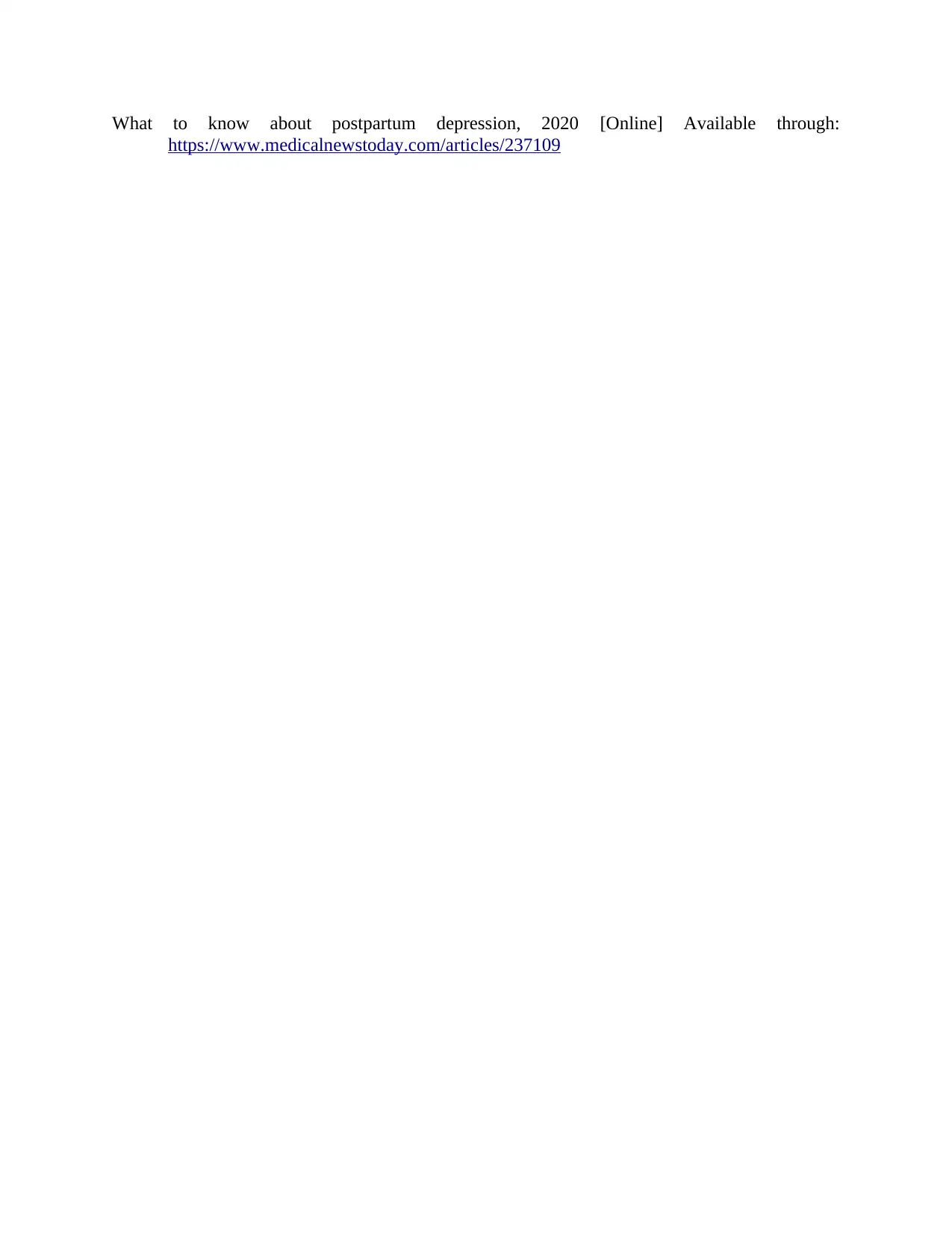
What to know about postpartum depression, 2020 [Online] Available through:
https://www.medicalnewstoday.com/articles/237109
https://www.medicalnewstoday.com/articles/237109
⊘ This is a preview!⊘
Do you want full access?
Subscribe today to unlock all pages.

Trusted by 1+ million students worldwide

1 out of 10
Related Documents
Your All-in-One AI-Powered Toolkit for Academic Success.
+13062052269
info@desklib.com
Available 24*7 on WhatsApp / Email
![[object Object]](/_next/static/media/star-bottom.7253800d.svg)
Unlock your academic potential
Copyright © 2020–2025 A2Z Services. All Rights Reserved. Developed and managed by ZUCOL.




